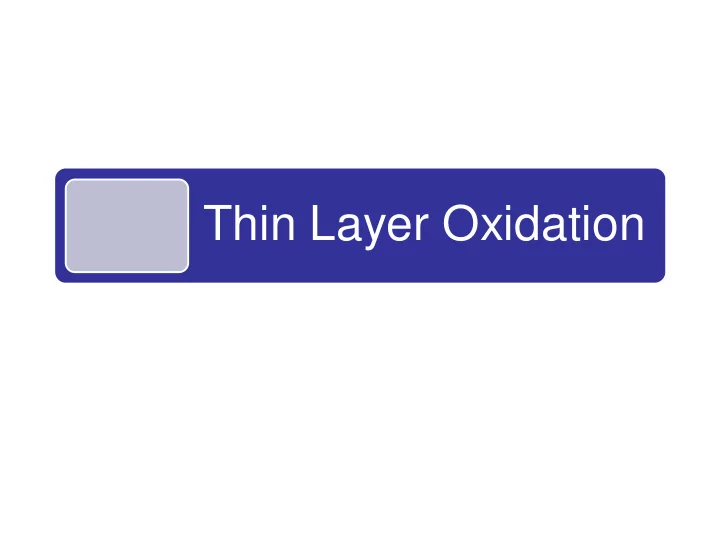

Thin Layer Oxidation
Concept of Clean Surface According to kinetic theory of gases, 1 cm 2 of a clean surface has about 10 15 atoms It will require just 1 second to form a monolayer of oxide scale at a pressure of about 10 -9 atms. Hence in order to understand the mechanism of thin layer regime, one must have chambers which can attain vacuum better than 10 -10 atm. Special Equipments such as AES/ESCA, SIMS, FEM, Ellipsometry are used to understand TLO. Since measurement of thin layer oxidation is very difficult, many theories are based upon empirical relationships and theoretical calculations.
Important aspect in TLO • Physical and Adsorption / Absorption Chemical Absorption Oxygen is absorbed on the clean metal surface to form chemisorbed layer Additional layers of oxide are build up via island growth possibly by place exchange mechanism Further growth of the oxide depends upon the transport of cations, anions or electrons through adsorbed monolayer. Kinetics of oxidation will be dependent upon how the transport occurs, which in turn depends upon the electron trap process, at the oxide gas interface, electron tunneling, or on the structure of oxide formed.
Place Exchange Mechanism of initial fast Growth
Kinetics of Low Temperature Oxidation • Direct Logarithmic Law X = A logt + B • Inverse Logarithmic Law 1/x = (A + C log t)
Cabrera Mott Theory Activation Energy W – ½ qaF
Ely & Wilkinsin Theory Ely & Wilkinsin assumed the activation energy of form : Where represents the contribution of the structure of the oxide : In net work structure cation is bound very tightly hence cannot move In network modifier cation has become lose because of sodium ions
Structure of Oxides Network modifier Structure of Na Glass Network Structure of SiO 2
Fehlner & Mott Theory Fehlner & Mott felt that in case of anion movement, it is the constant fields Rather than constant potential as assumed in Cabrera Mott theory, Hence this theory be modified to take account of it. Also the activation energy must have an other term x in additional 1/2qaF to Take care of structural effects Based upon this the activation energy can be given as; W – 1/2qaF+ x Based upon this activation energy, the kinectics were found to be logarithmic.
Mott Theory of Electron Tunneling • The probability of an electron sitting at the bottom of well can be given by • Dx/dt =C” exp [ -2x(2mU) 1/2 / h] Electron at bottom U – barrier height of well h – planks’ constant
Thick Layer Oxidation Wagner’s Theory of Oxidation
Assumption of Wagner’s Theory The oxide scale is compact and adherent. Migration of charged species, ions (cations or anions), electron or electron holes is the rate controlling process. Thermodynamic equilibrium is established at both the metal/scale and scale/gas interface The oxide is more or less stoichiometric – there is very little deviation from stoichiometry. Oxygen solubility in the metal may be neglected.
Movement of Charge Species During Scale Formation
when a charged particle “i” ( anion, cation or electron) with a charge Z i is moving with a chemical potential of d i /dx and electrical potential of d /dx, it experience a force of :
Approximations
Relationship between Mobility and Diffusion Coefficient
An Example of Waners’ Model on Oxidation of Zn
Recommend
More recommend